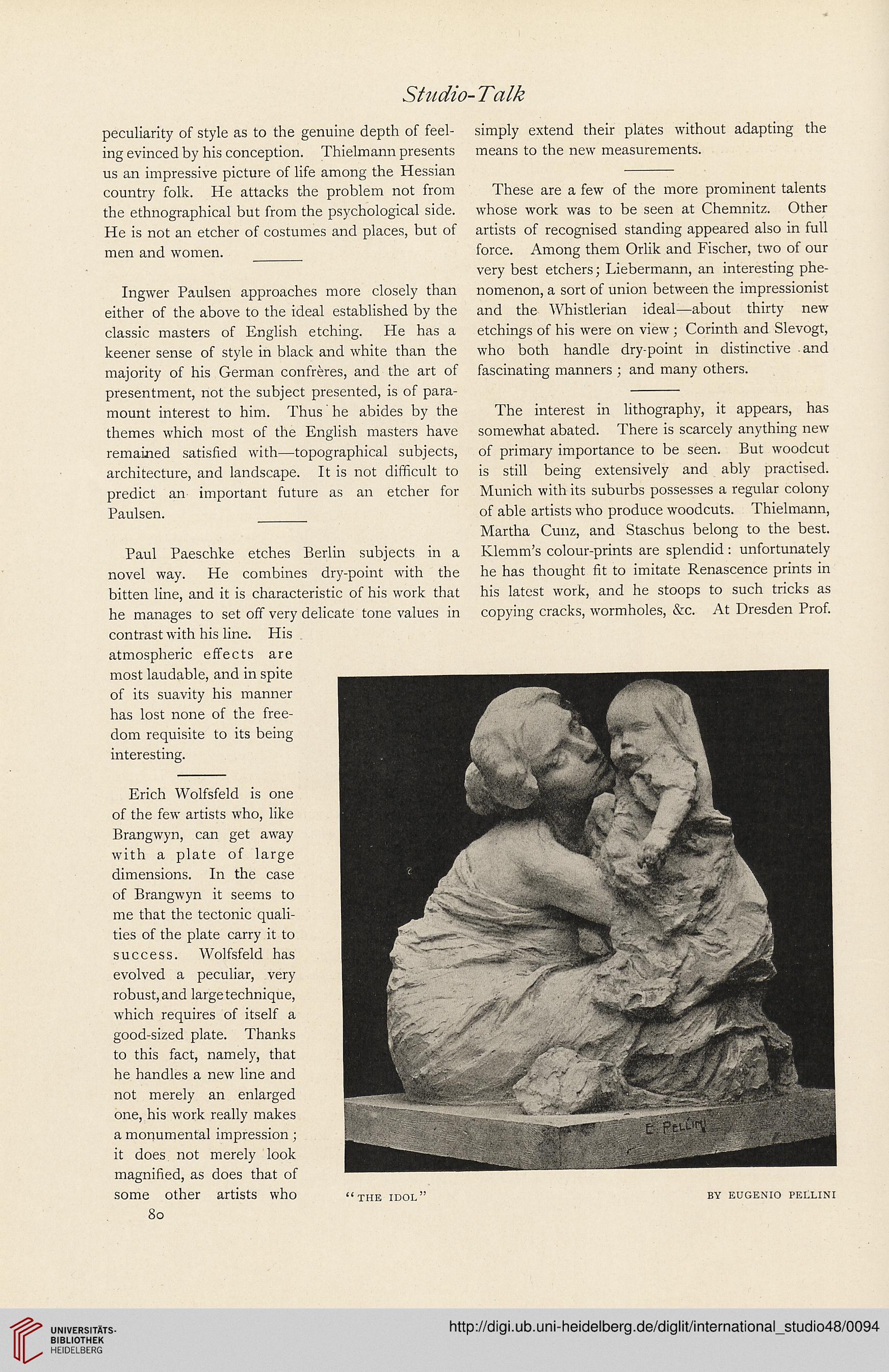Studio-Talk
peculiarity of style as to the genuine depth of feel-
ing evinced by his conception. Thielmann presents
us an impressive picture of life among the Hessian
country folk. He attacks the problem not from
the ethnographical but from the psychological side.
He is not an etcher of costumes and places, but of
men and women. _
Ingwer Paulsen approaches more closely than
either of the above to the ideal established by the
classic masters of English etching. He has a
keener sense of style in black and white than the
majority of his German confreres, and the art of
presentment, not the subject presented, is of para-
mount interest to him. Thus he abides by the
themes which most of the English masters have
remained satisfied with—topographical subjects,
architecture, and landscape. It is not difficult to
predict an important future as an etcher for
Paulsen.
Paul Paeschke etches Berlin subjects in a
novel way. He combines dry-point with the
bitten line, and it is characteristic of his work that
he manages to set off very delicate tone values in
contrast with his line. His
simply extend their plates without adapting the
means to the new measurements.
These are a few of the more prominent talents
whose work was to be seen at Chemnitz. Other
artists of recognised standing appeared also in full
force. Among them Orlik and Fischer, two of our
very best etchers; Liebermann, an interesting phe-
nomenon, a sort of union between the impressionist
and the Whistlerian ideal—about thirty new
etchings of his were on view ; Corinth and Slevogt,
who both handle dry-point in distinctive and
fascinating manners ; and many others.
The interest in lithography, it appears, has
somewhat abated. There is scarcely anything new
of primary importance to be seen. But woodcut
is still being extensively and ably practised.
Munich with its suburbs possesses a regular colony
of able artists who produce woodcuts. Thielmann,
Martha Cunz, and Staschus belong to the best.
Klemm’s colour-prints are splendid : unfortunately
he has thought fit to imitate Renascence prints in
his latest work, and he stoops to such tricks as
copying cracks, wormholes, &c. At Dresden Prof.
atmospheric effects are
most laudable, and in spite
of its suavity his manner
has lost none of the free-
dom requisite to its being
interesting.
Erich Wolfsfeld is one
of the few artists who, like
Brangwyn, can get away
with a plate of large
dimensions. In the case
of Brangwyn it seems to
me that the tectonic quali-
ties of the plate carry it to
success. Wolfsfeld has
evolved a peculiar, very
robust, and large technique,
which requires of itself a
good-sized plate. Thanks
to this fact, namely, that
he handles a new line and
not merely an enlarged
one, his work really makes
a monumental impression;
it does not merely look
magnified, as does that of
some other artists who
80
“THE idol” BY EUGENIO PELLINI
peculiarity of style as to the genuine depth of feel-
ing evinced by his conception. Thielmann presents
us an impressive picture of life among the Hessian
country folk. He attacks the problem not from
the ethnographical but from the psychological side.
He is not an etcher of costumes and places, but of
men and women. _
Ingwer Paulsen approaches more closely than
either of the above to the ideal established by the
classic masters of English etching. He has a
keener sense of style in black and white than the
majority of his German confreres, and the art of
presentment, not the subject presented, is of para-
mount interest to him. Thus he abides by the
themes which most of the English masters have
remained satisfied with—topographical subjects,
architecture, and landscape. It is not difficult to
predict an important future as an etcher for
Paulsen.
Paul Paeschke etches Berlin subjects in a
novel way. He combines dry-point with the
bitten line, and it is characteristic of his work that
he manages to set off very delicate tone values in
contrast with his line. His
simply extend their plates without adapting the
means to the new measurements.
These are a few of the more prominent talents
whose work was to be seen at Chemnitz. Other
artists of recognised standing appeared also in full
force. Among them Orlik and Fischer, two of our
very best etchers; Liebermann, an interesting phe-
nomenon, a sort of union between the impressionist
and the Whistlerian ideal—about thirty new
etchings of his were on view ; Corinth and Slevogt,
who both handle dry-point in distinctive and
fascinating manners ; and many others.
The interest in lithography, it appears, has
somewhat abated. There is scarcely anything new
of primary importance to be seen. But woodcut
is still being extensively and ably practised.
Munich with its suburbs possesses a regular colony
of able artists who produce woodcuts. Thielmann,
Martha Cunz, and Staschus belong to the best.
Klemm’s colour-prints are splendid : unfortunately
he has thought fit to imitate Renascence prints in
his latest work, and he stoops to such tricks as
copying cracks, wormholes, &c. At Dresden Prof.
atmospheric effects are
most laudable, and in spite
of its suavity his manner
has lost none of the free-
dom requisite to its being
interesting.
Erich Wolfsfeld is one
of the few artists who, like
Brangwyn, can get away
with a plate of large
dimensions. In the case
of Brangwyn it seems to
me that the tectonic quali-
ties of the plate carry it to
success. Wolfsfeld has
evolved a peculiar, very
robust, and large technique,
which requires of itself a
good-sized plate. Thanks
to this fact, namely, that
he handles a new line and
not merely an enlarged
one, his work really makes
a monumental impression;
it does not merely look
magnified, as does that of
some other artists who
80
“THE idol” BY EUGENIO PELLINI




